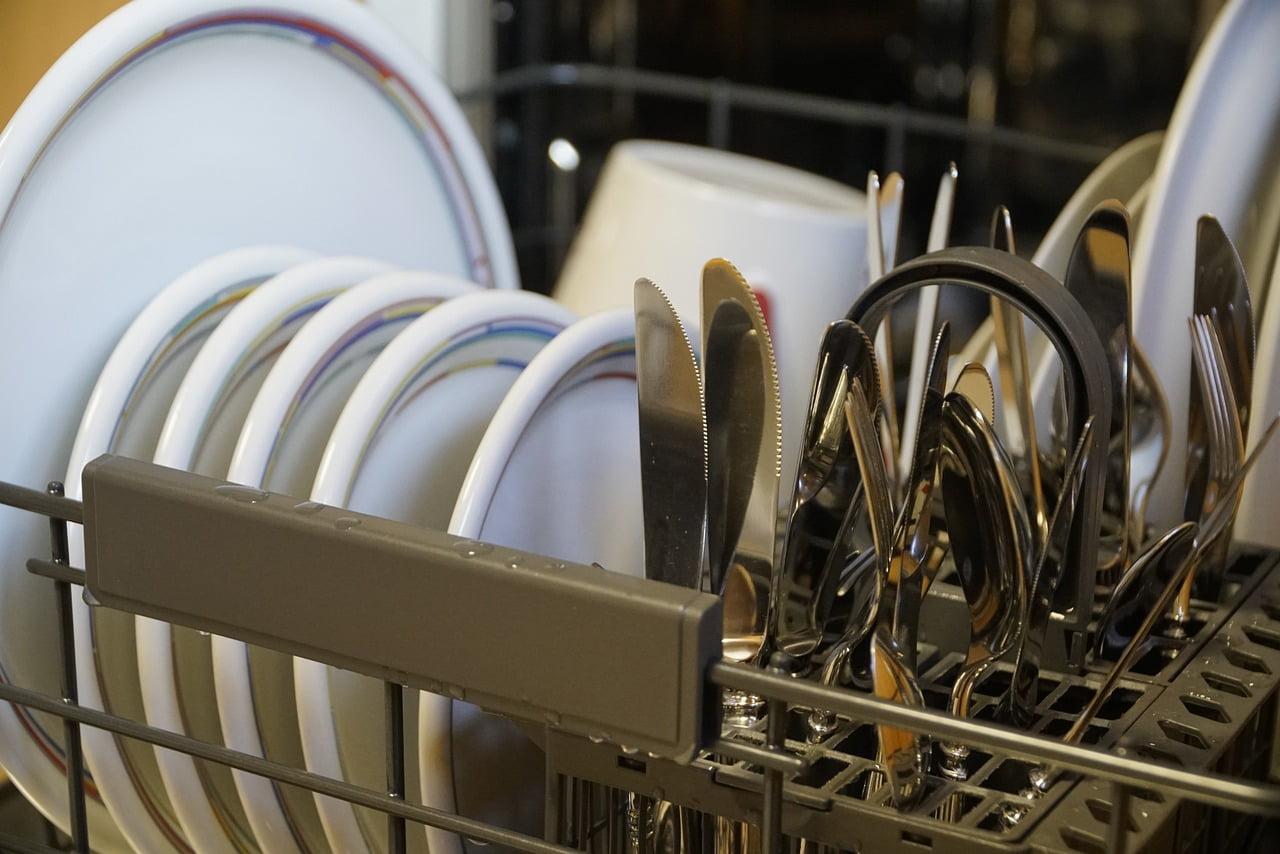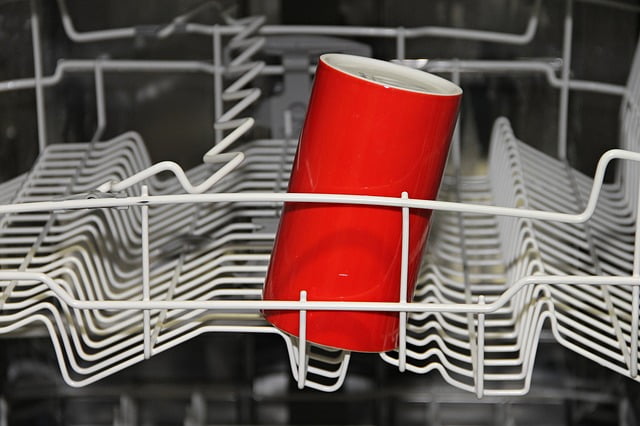HOW TO CLEAN A DISHWASHER THE EASY WAY
Smelly sponge on the bottom of the sink, gunky greasy residue on your favorite dishes… sound about as fun as doing the dishes? We hear you! Before you reach for the dish soap and scrubbers, there is a way to tackle the gunk before it starts taking over your kitchen. Let’s talk about cleaning your dishwasher – a surprisingly simple 5 step process that will have your dishwasher gleaming in no time!
Clean a Dishwasher with Vinegar
Cleaning a dishwasher with vinegar is an effective and affordable way of getting the job done. Vinegar naturally contains acetic acid, which kills bacteria and germs while also helping to reduce soap scum, lime scale, and mineral buildup. Additionally, its acidity breaks down any food particles and grease that remain on the dishwasher filters, trays, and other parts. To clean your dishwasher with vinegar:
1. Begin by filling a bowl half full with white vinegar. Place the bowl in the top rack of the dishwasher and close the door.
2. Set the dishwasher for a “normal” cycle, then turn it on and let it run for about five minutes before turning it off again.
3. Allow the vinegar to sit in the dishwasher for up to an hour. The longer you wait, the more vinegar will be able to work its magic deep within the surfaces of your dishwasher.
4. Restart the “normal” cycle with hot water this time (but without any detergent) to rinse off all remaining traces of vinegar in your dishwasher.
5. Open up the door and check that all areas are scrubbed clean before unloading your dishes as normal.
There is some debate over whether cleaning a dishwasher with vinegar is safe; some experts claim that due to its acidic properties, vinegar can corrode certain parts of your dishwasher over time if used too often or not in moderate amounts. However, others believe that equipment should be replaced after about five years anyway, so unless you keep your current dishwasher for much longer than that, you should be free from any damage that could otherwise have been caused by using excessive amounts of vinegar on it. Ultimately, though, it’s best to exercise caution when using this method – use only recommended amounts of vinegar as suggested above and never overuse it throughout any given cycle either, just to ensure no harm comes to your machine.
Now that we’ve discussed how to clean a dishwasher with vinegar, let’s move on to cleaning the inside of it in our next section…
Cleaning Cleaning the Inside
Cleaning the Inside: The inside of your dishwasher should be regularly cleaned to keep it free from food and soap residue build up. Depending on your dishwasher model, it can be a bit tricky to even reach the inside parts. In most models, you will need to remove the lower spray arm to assess the interior easily. To do this, first use a screwdriver or an Allen wrench to unscrew the central nut located beneath the arm. Once you have removed the screw, gently take out the spray arm and wash it in a sink full of warm, soapy water.
In some cases, there are different ways to clean the interior. Some recommend that you use a damp cloth soaked in white vinegar and gently wipe away any food particles or grease spots that might be present. Others say that you should use a commercial detergent with decreasing properties for this task. You will have to select what cleaning method works best for you depending on how bad the interior is and how much time you have available for its maintenance.
When it comes to actually cleaning the interior, regardless of what type of cleaner you choose, always make sure that you rinse all parts properly before putting them back in place. As soon as all surfaces have been cleaned, you can start reassembling your dishwasher by installing each part as it was before disassembling them. Finally, let your dishwasher run an empty cycle with hot water afterwards so that any smell of detergent or vinegar can be removed if necessary.
Leading into the next Section: Now that we are discussing cleaning the inside of your dishwasher, let’s move on to discuss cleaning the waterline in our next section.
Cleaning the Waterline
Cleaning the Waterline: For proper sanitation and to ensure the dishwasher is doing its job optimally, it’s important to clean the waterline to keep it free from debris and buildup. To clean the waterline, you will need a small bottle brush. Start by removing all dishes from the dishwasher and unload any dirt or debris from the filter traps. After that, take your bottle brush and use it to scrape off any residue or food buildup along the rubber waterline. Focus on making sure that no dirt or particles are caught up in that area, since they can contaminate your dishes while they’re being washed.
Now we debate both sides of this argument: you could choose to either manually scrub the waterline with a brush or use a chemical cleaning agent on it. Both options have pros and cons associated with them. Scrubbing the waterline by hand can help you get into tight spots and really get rid of any extra build-up but some may find this to be tedious and hard work. On the other hand, using a chemical cleaning agent may be simpler for some people because it doesn’t require as much effort, but you have to make sure that you select a product that is dishwasher-safe. Ultimately, it comes down to personal preference when deciding which route is best for cleaning your dishwasher’s waterline.
No matter which method you choose, once you’ve scraped away any residue or buildup from the waterline, use a damp cloth to completely remove any soapy residue before proceeding to the next step: cleaning the heating element.
- According to the Institute of Inspection Cleaning and Restoration Certification, running a hot water cycle with detergent can help remove food residue and odors from your dishwasher.
- Studies conducted in 2018 found that adding vinegar to your dishwasher while running a hot water cycle can help reduce lime scale buildup, resulting in improved performance.
- An analysis published in 2019 concluded that performing regular maintenance such as cleaning both inside and outside surfaces of the dishwasher can increase its lifespan by up to 25%.
Key Takeaway
The waterline of a dishwasher should be routinely cleaned in order to keep it free of debris and buildup. This can be done by either manually scrubbing the waterline with a bottle brush, using a chemical cleaning agent, or both. After scraping away residue or buildup, it is important to use a damp cloth to remove any soapy residue before cleaning the heating element. Ultimately, it comes down to personal preference when deciding which method is best for cleaning your dishwasher’s waterline.
Cleaning the Heating Element
Cleaning the heating element is an important part of making sure your dishwasher works effectively. The heating element helps to ensure that the water in the dishwasher gets hot enough to help break down grease and food particles on dishes, utensils, and cookware. To help make sure your dishwasher is running as efficiently as possible, it’s important to give the heating element a thorough cleaning every few months.
First, turn off power to the dishwasher at the circuit breaker. Then remove all racks so that you have access to the heating element. Wipe down any debris or dirt with a damp cloth to get rid of any buildup from around the area near the heating element. Once this is done, you can use an old toothbrush and some vinegar diluted with water to scrub off hard-to-reach areas. Finally, rinse off any remaining vinegar with a damp cloth.
While cleaning the heating element may seem like an unnecessary and tedious task, it is still a very important part of maintaining your dishwasher’s overall efficiency and extending its life span. Regularly checking and cleaning your dishwasher’s heating element will help keep your machine running strong for years to come.
Now that you’ve finished cleaning the heating element, it’s time to move on to getting dishes clean by ensuring they are properly loaded into your machine. The next section will provide tips on how to get dishes clean in less time and with fewer headaches.
Tips for Getting Dishes Clean
When it comes to getting dishes clean, there are several tips worth considering. For starters, pre-rinse the dishes, especially if they have large pieces of food stuck to them. Using a scraper and brush to remove excess food before placing dishes into the dishwasher can often help ensure a better clean. When loading the dishwasher, avoiding stacking items too close together and ensuring that the sprayers are not blocked by heavy items can make all the difference. Taking time to read and follow the specific instructions on each type of dish is essential in order to optimize the cleaning process.
Another popular tip is to use a rinse aid product, as this helps dishes dry faster and prevents any residue from collecting on them while wet. The choice between liquid and powder detergent is largely a matter of preference – both offer good cleaning results regardless. Many detergents also contain special stains removing agents which can be beneficial for particularly dirty loads.
Obviously, there are two schools of thought when it comes to how dishes should be loaded in the dishwasher: faced up or faced down. Proponents of placing dishes faced up cite easier unloading, better air circulation and less chance of water being trapped in crevices as reasons to do so; whereas those on team faced down believe that water directing jets provide better power washing action when facing down. Ultimately, both methods can lead to clean dishes provided that you give your machine and task at hand some extra TLC!
With these tips in mind and an understanding of basic machine maintenance, your dishwasher should run smoothly and get those dishes sparkling clean every time! Now that you know how to get dishes clean with ease, let’s move on to deeper matters – deep cleaning a dishwasher!
Deep Cleaning a Dishwasher
Deep cleaning a dishwasher is an important step to take every few months. After a deep clean, dishes can come out of the dishwasher sparkling clean. Deep cleaning will also help make sure your dishwasher lasts for as long as possible. Before beginning, you must ensure that all of the dishes have been taken out of the dishwasher and that it is empty.
There are several methods available for deep cleaning a dishwasher. Vinegar and baking soda are two popular approaches to deodorizing a dishwasher and removing soap residue from the interior components. Vinegar is an acid which helps boost detergent performance and has antibacterial properties that can help reduce bacteria buildup in the dishwasher. Baking soda acts as an abrasive cleaner and helps scrub away mineral deposits left after rinsing with water.
For some homeowners, using commercial products specifically designed to clean a dishwasher may be preferred. These products often include powerful agents such as bleach or enzymes that can break down hard-to-remove stains or odors from the inside of the dishwasher. When using this method, it is important to follow the manufacturer’s instructions carefully to avoid damaging your dishwasher over time.
Another method for deep cleaning a dishwasher is to use steam or hot water to blast away dirt and grime from inside the machine. This can be done by filling a metal bowl with boiling water, placing it on the bottom rack in the center of the dishwasher and running it on high heat for 15 minutes. The heat from the steam should dissolve any residue built up in your dishwasher over time. Many homeowners opt for this approach since it is safe, non-toxic and uses nothing but hot water.
No matter what approach you choose, performing a deep clean of your dishwasher once every few months is essential if you want fresh smelling dishes every time! Now let’s move onto scrubbing away soap scum – one of the most challenging parts of keeping your dishwasher clean.

Scrub Away Soap Scum
When it comes to scrubbing away soap scum in your dishwasher, you have a few options. You can use a store-bought cleaning product, or you could make your own with household ingredients.
If you choose the store-bought approach, make sure to read the instructions carefully. Most products will require that you run an empty cycle with no dishes first before applying the cleaning solution. Once applied, follow the instructions on the bottle for proper application and wait the recommended amount of time before running another cycle with no dishes.
Another option is to make your own cleaning solution from ordinary household items such as baking soda, white vinegar, and lemon juice. For this approach, dissolve 1/2 cup of baking soda into 1 quart of warm water and pour it into the bottom of the dishwasher. Then add 1 cup of white vinegar to where your detergent usually goes and start a regular cycle with no dishes. Once done, open the door during the final rinse cycle and sprinkle 1/2 cup of lemon juice inside. Close the door and let the cycle complete.
No matter which option you decide to go for, it’s important to regularly clean out soap scum not only to keep your dishwasher running optimally but also to protect your dishes from chemical residue that could be left behind on them.
Regular cleaning maintenance is key to avoiding further buildup of soap scum in your dishwasher and should become part of your regular routine when doing household chores. In the next section, we’ll discuss how often you should clean out your dishwasher and offer some easy maintenance tips that can help keep any buildup under control.
Regular Cleaning Maintenance
Regular cleaning maintenance is essential to appropriately maintain a dishwasher and keep it operating at its peak efficiency. Depending on how often the dishwasher is used, parts and areas of the appliance should be cleaned on a semi-annual or annual basis. These periodic maintenance checks go beyond simply running a hot cycle with vinegar to ensure all of the inner moving parts are working properly.
One of the main debate points in terms of regular cleaning maintenance for dishwashers is whether it should be done by the homeowner or if a professional cleaning service should be retained. While some may claim that there is no need for professional services because dishwashers run more efficiently when maintained by their users, others take the position that only a professional cleaner can sufficiently access and clean all of the different components of the appliance.
In conclusion, regular cleaning maintenance for dishwashers easy to do at home provided one has a general understanding of the appliance and access to necessary tools and supplies. But at times it is best to consult a professional cleaner if any signs of malfunction are visible, as they can provide an expert opinion as well as aid in both the removal and replacement of any worn or damaged parts. With this in mind, we will now move on to conclusion in our guide on performing complete and successful dishwasher cleaning in five simple steps!
Conclusion
Cleaning your dishwasher properly and on a regular basis will help ensure it is running in top form, which can be vital for an energy-efficient and reliable kitchen appliance. With five simple steps, you can quickly deep clean a dishwasher to keep it operating as efficiently as possible. First, scrape and remove any debris from the filter and drain at the bottom of the dishwasher. Second, run a cycle with white vinegar or citric acid to help reduce the lime scale and bacteria build up. Third, use a toothbrush or other small brush to scrub out the crevices of your dishwasher door and roller tracks, if applicable. Fourth, replace the filter if needed and clean off any excess residue around the edges with a damp cloth before reinstalling it. Finally, once everything is cleansed and put back together, run another hot cycle with detergent to ensure that all areas are free of dirt and grease.
It is important to strike a balance between cleaning your dishwasher regularly and not over-cleaning it. Excessive cleaning products such as bleach or degreasers can damage internal parts, cause the appliance to overheat, lead to ineffective cleaning results, and void manufacturer’s warranties. Therefore, running through these five steps every few months should be sufficient for keeping your dishwasher in tip-top shape for many years to come

Follow us

